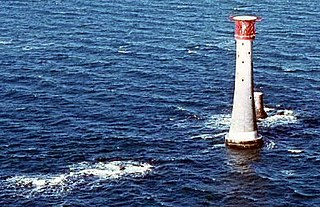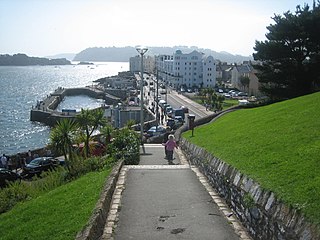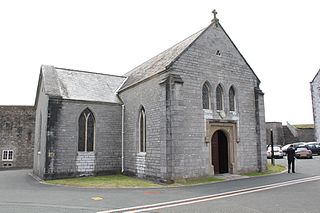
Plymouth is a port city and unitary authority in South West England. It is located on the south coast of Devon, approximately 36 miles (58 km) south-west of Exeter and 193 miles (311 km) south-west of London. It is bordered by Cornwall to the west and south-west.

Plymouth Sound, or locally just The Sound, is a deep inlet or sound in the English Channel near Plymouth in England.

John Smeaton was a British civil engineer responsible for the design of bridges, canals, harbours and lighthouses. He was also a capable mechanical engineer and an eminent physicist. Smeaton was the first self-proclaimed "civil engineer", and is often regarded as the "father of civil engineering". He pioneered the use of hydraulic lime in concrete, using pebbles and powdered brick as aggregate. Smeaton was associated with the Lunar Society.

The Eddystone Lighthouse is a lighthouse that is located on the Eddystone Rocks, 9 statute miles (14 km) south of Rame Head in Cornwall, England. The rocks are submerged below the surface of the sea and are composed of Precambrian gneiss.

Corineus, in medieval British legend, was a prodigious warrior, a fighter of giants, and the eponymous founder of Cornwall.

The Eddystone or Eddystone Rocks are a seaswept and eroded group of rocks ranging 9 miles (14 km) southwest of Rame Head in Cornwall, England, United Kingdom. Although the nearest point on the mainland to the Eddystone is in Cornwall, the rocks fall within the city limits of Plymouth, and hence within the county of Devon.

The Royal Citadel in Plymouth, Devon, England, was built in the late 1660s to the design of Sir Bernard de Gomme. It is at the eastern end of Plymouth Hoe overlooking Plymouth Sound, and encompasses the site of the earlier fort that had been built in the time of Sir Francis Drake. The citadel site is a Scheduled Monument and many of the buildings within are Grade II Listed.

Smeaton's Tower is a memorial to civil engineer John Smeaton, designer of the third and most notable Eddystone Lighthouse. A major step forward in lighthouse design, Smeaton's structure was in use from 1759 to 1877, until erosion of the ledge it was built upon forced new construction. The tower was largely dismantled and rebuilt on Plymouth Hoe in Plymouth, Devon, where it stands today.
Oreston, formerly a village on the southern bank of the Cattewater, is now a suburb of Plymouth. It is recorded as Horestone on the 1591 Spry Map of Plimmouth. Oreston offers many small, local services. It is home to a small cornershop style shop called "The Quay News," a pub called "The King's Arms," a small dock and free public slipway in "Oreston Quay," and is home to approximately 3,000 residents.
Plymstock School is a state comprehensive secondary school in Plymstock, a suburb of Plymouth, Devon, England. It was the first West Devon comprehensive school and is now a Specialist Sports College. As of January 2011 it has 1,626 students, of whom 240 are in the sixth form. In April 2011, the school became an academy.

Theatre Royal, Plymouth, is a theatre venue in Plymouth, Devon. It consists of a 1,300-seat main auditorium, The Lyric, which regularly hosts large-scale musicals, opera and ballet; a 200-seat studio, The Drum; and a 50-seat studio, The Lab. On a separate site, Theatre Royal Plymouth also has a production and learning centre, TR2, featuring rehearsal studios and workshops for the production of set and costumes.

West Hoe is an area of Plymouth in the English county of Devon.

The History of Plymouth in Devon, England, extends back to the Bronze Age, when the first settlement began at Mount Batten a peninsula in Plymouth Sound facing onto the English Channel. It continued as both a fishing and continental tin trading port through the late Iron Age into the Early Medieval period, until the more prosperous Saxon settlement of Sutton, later renamed Plymouth, surpassed it. With its natural harbour and open access to the Atlantic, the town found wealth and a national strategic importance during the establishment of British naval dominance in the colonisation of the New World. In 1620 the Pilgrim Fathers departed from Plymouth to establish the second English colony in America. During the English Civil War the town was besieged between 1642 and 1646 by the Royalists, but after the Restoration a Dockyard was established in the nearby town of Devonport. Throughout the Industrial Revolution Plymouth grew as a major mercantile shipping industry, including imports and passengers from the US, whilst Devonport grew as a naval base and ship construction town, building battleships for the Royal Navy – which later led to its partial destruction during World War II in a series of air-raids known as the Plymouth Blitz. After the war was over, the city centre was completely rebuilt to a new plan.

Drake is an election ward within Plymouth, Devon, England. One of the main roads from the city to Tavistock and Dartmoor runs through the ward. In the past it played an important role in the supply of water to Plymouth, and it was the location of both a fatal bomb explosion and a large unexploded bomb during the Plymouth Blitz. The University of Plymouth has its main campus in this ward and the large student population has led to part of it being designated as one of the four areas subject to Designated Public Places Orders in the city. It is also the location of the city's main railway station, museum and public library.

The Royal Chapel of St Katherine-upon-the-Hoe is the garrison church within the precincts of the Royal Citadel in Plymouth. The original church on the site was licensed for services by the Bishop of Exeter, Thomas de Brantingham, in 1371. During the period 1666–1671, the original building was demolished and the present nave, chancel and sanctuary were rebuilt on the same site. The galleries and transepts were added in 1845 and give a symmetrical cross-like structure to the building.
The following is a timeline of the history of the city of Plymouth, Devon, England.

The Armada Memorial is a monument on Plymouth Hoe, Plymouth, Devon, England. Built in 1888, the monument celebrates the tercentenary of the defeat of the Spanish Armada, which was sighted by English captains stationed in the city. It is a granite structure, decorated with bronze crests and a statue of Britannia.


















